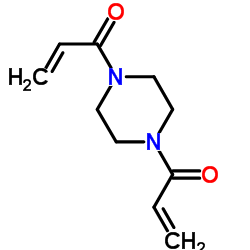1,1'-piperazine-1,4-diylbisprop-2-en-1-one

1,1'-piperazine-1,4-diylbisprop-2-en-1-one structure
|
Common Name | 1,1'-piperazine-1,4-diylbisprop-2-en-1-one | ||
|---|---|---|---|---|
| CAS Number | 6342-17-2 | Molecular Weight | 194.230 | |
| Density | 1.1±0.1 g/cm3 | Boiling Point | 434.1±25.0 °C at 760 mmHg | |
| Molecular Formula | C10H14N2O2 | Melting Point | 91.5-93.5 °C(lit.) | |
| MSDS | Chinese USA | Flash Point | 216.5±15.5 °C | |
| Symbol |

GHS07 |
Signal Word | Warning | |
|
Peroxiredoxin I protein, a potential biomarker of hydronephrosis in fetal mice exposure to 2,3,7,8-tetrachlorodibenzo-p-dioxin.
J. Pediatr. Urol. 10(3) , 474-81, (2014) In previous studies, we established an animal model of human congenital hydronephrosis with exposure of developing mice to 2,3,7,8-tetrachlorodibenzo-p-dioxin (TCDD), but the etiopathogenesis is not entirely clear. The present study was to identify the change... |
|
|
Urine proteome analysis in Dent's disease shows high selective changes potentially involved in chronic renal damage.
J. Proteomics 130 , 26-32, (2015) Definition of the urinary protein composition would represent a potential tool for diagnosis in many clinical conditions. The use of new proteomic technologies allows detection of genetic and post-trasductional variants that increase sensitivity of the approa... |
|
|
ECM stiffness primes the TGFβ pathway to promote chondrocyte differentiation.
Mol. Biol. Cell 23 , 3731-42, (2012) Cells encounter physical cues such as extracellular matrix (ECM) stiffness in a microenvironment replete with biochemical cues. However, the mechanisms by which cells integrate physical and biochemical cues to guide cellular decision making are not well defin... |
|
|
Application of MeCAT-Click labeling for protein abundance characterization of E. coli after heat shock experiments.
J. Proteomics 136 , 68-76, (2016) In a proof of concept study, metal-coded affinity tags based on click chemistry (MeCAT-Click) were used to analyze the proteome of Escherichia coli (E. coli) in response to heat stress. This allows high labeling efficiency, high detection sensitivity, and mul... |
|
|
Methods for increasing the resolution of two-dimensional protein electrophoresis.
Anal. Biochem. 173 , 424, (1988) A two-dimensional gel elctrophoresis protocol has been developed which provides for a 1.5-to 3-fold increase in the resolution of proteins compared to other frequently used methods. The major variations from previous protocols include increased pore size in t... |
|
|
Development of polyacrylamide gels that improve the separation of proteins and their detection by silver staining.
Anal. Biochem. 173 , 412-423, (1988) Background staining that is associated with silver detection of proteins and nucleic acids in polyacrylamide gels has been shown to be due mostly to the amide groups in methylenebisacrylamide, a commonly used gel crosslinker. In attempts to reduce this backgr... |
|
|
The rational use of hydrophobic effect-based recognition in molecularly imprinted polymers.
J. Mol. Recognit. 11(1-6) , 94-7, (1998) A novel molecularly imprinted polymer (MIP) system selective for D-phenylalanine is described where polymerization is performed in aqueous solution. The unique polymer system comprises a hydrophobic moiety-selective functional monomer, polymerizable beta-cycl... |
|
|
Crosslinking with diacrylylpiperazine (PIP) reduces activation of complement by polyacrylamide microcapsules.
Biomater. Artif. Cells Immobilization Biotechnol. 19(4) , 667-74, (1991) Activation of the complement system in vitro by a series of microcapsules based on polylysine, alginate or polyacrylamide was determined. Least activation was observed with microcapsules whose outer layer was composed of polyacrylamide. Activation was further... |
|
|
An update on conformation sensitive gel electrophoresis.
Hum. Mutat. 19(4) , 334-42, (2002) Conformation-sensitive gel electrophoresis (CSGE) was developed as a method of heteroduplex analysis to screen large multi-exon genes for sequence variation. The novelty of the method was in the use of a non-proprietary acrylamide gel matrix that used 1,4-bis... |
|
|
Fractionation techniques in a hydro-organic environment. II. Acryloyl-morpholine polymers as a matrix for electrophoresis in hydro-organic solvents.
Anal. Biochem. 137 , 420-428, (1984) The properties of gels prepared either from acryloyl-morpholine (ACM) or from its mixtures with acrylamide and crosslinked either with bisacrylylpiperazine or with methylenebisacrylamide have been described. ACM-containing gels are compatible with organic sol... |